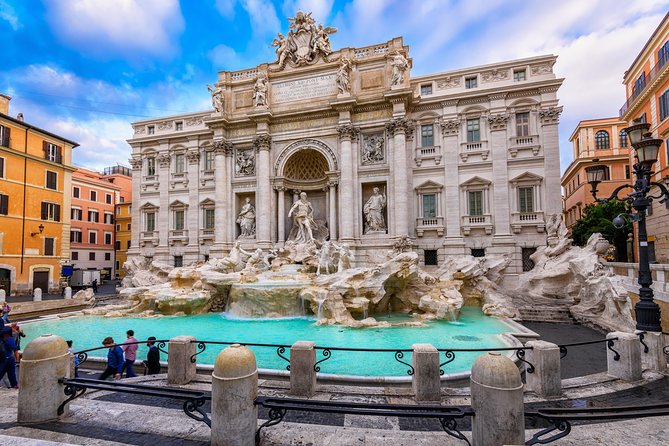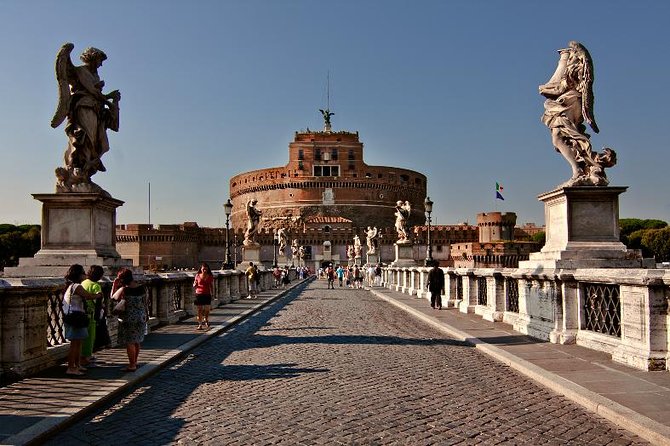
Panoramic Views tour Rome Palatine Hill, Roman Forum, Colosseum
Explore the heart of ancient Rome with an exceptional guided tour. Start from Piazza del Campidoglio, built by Michelangelo, and enjoy a breathtaking view of Rome. Explore the Basilica, the markets, and the splendid Trajan's Column. Passing through an underground tunnel, reach the Forum of Julius Caesar here; over the centuries, the emperors have left their mark by building imposing and monumental buildings for different uses and destinations, making this place unique for the quality and quantity of buildings present. Walk on the Via Sacra, which is 2500 years old, and pass the Arch of Titus, and reach the Palatine Hill on which Rome was founded in 753 BC. Enjoy spectacular views and admire the ruins of the Imperial Palaces. Admire the Arch of Constantine and the best-preserved part of the Colosseum and learn about this glorious building and construction techniques, stories about the bloody and spectacular fights between gladiators, wild animals, and naval battles.
Options
Private Roman Forum Tour
What's included in Panoramic Views tour Rome Palatine Hill, Roman Forum, Colosseum
(Subject to Option Inclusions)Itinerary
Piazza del Campidoglio
This square, from where you can enjoy panoramic views, was born according to the criteria of a uniform project due to the genius of Michelangelo; it stands on the Capitoline hill, where an ancient village was located, and the place was chosen to dedicate numerous temples to the Roman deities. In 1536, on the occasion of the visit to Rome of the Spanish emperor Charles V, Piazza del Campidoglio underwent a series of transformations due to the severe state of abandonment in which the hill found itself. Pope Paul III commissioned Michelangelo to complete the overall layout of the square. The Florentine architect created an elegant podium for the equestrian statue of Marcus Aurelius, placed in the center of the hill in 1537. Hence, this became the fulcrum of the new urban project. Furthermore, Buonarroti designed an imposing staircase with giant steps, the "Cordonata," which allowed knights to climb quickly, culminating with the solemn balustrade surmounted by classic marble groups.
Foro di Traiano
It was obtained by cutting the Quirinale and the Campidoglio slopes, connected by a mountain saddle. The excavation works were probably started under Domitian, in parallel with the arrangement of the Forum of Nerva. The undertaking, which had to be interrupted after the death of this emperor, murdered in a conspiracy in 96 AD, was continued by Trajan and financed with the booty obtained from the conquest of Dacia (now Romania), conducted in two subsequent military campaigns (101 -102 and 105-106 AD) and ended with the defeat and submission of the Dacians and the death of their king Decebalus. The architect of the work was Apollodorus of Damascus, a military engineer who had accompanied the emperor in the victorious war. The plan of Trajan's Forum was more articulated and complex than that of its predecessors: it included a vast square flanked by porticoes with exedras behind them, dominated on one side by the imposing Basilica Ulpia, behind which stood the Trajan's Column.
Colonna Traiana
Trajan's Column narrates in images the two military campaigns of 101-102 and 105-106 AD. with which the emperor Trajan (98-117 AD) conquered Dacia, mainly corresponding to present-day Romania. Thanks to the extraordinary war booty, Trajan was able to build the most majestic of the Forums of Rome, which took its name from him and was inaugurated in 112 AD. The Column was erected in the center of a courtyard delimited by the monumental entrance to the Forum by the Basilica Ulpia and by the two libraries to the east and west. It rests on a base decorated with bas-reliefs depicting stacks of weapons. The shaft, 100 Roman feet high (30 meters), is composed of 17 colossal rocks of white Carrara marble, with a diameter of almost 4 meters. Inside is a spiral staircase of 185 steps leading to the top. The frieze is arranged around the shaft, imagined as a spirally wrapped scroll, approximately 200 meters long in total and densely animated with scenes with about 2,500 characters.
Inclusions
- Professional Licensed Local Blue Badge Tour Guide
- Radio and headsets to hear your guide clearly
- Entry/Admission Trajan Forum, Roman Forum, Palatine Hill and Imperial Forum
- Colosseum admission tickets
- Gratuities
- Hotel pickup and drop-off
- Transportation to/from attractions
- Food and drinks
- Infants and small children can ride in a pram or stroller
- Service animals allowed
- Public transportation options are available nearby
- Not recommended for pregnant travelers
- Not recommended for travelers with poor cardiovascular health
- Suitable for all physical fitness levels
- At the time of booking, traveler must provide their full name. All travelers are requested to provide a valid ID card when entering the Roman Forum. Failure to provide a valid ID card will result in denied entry to the Trajan Forum and the Roman Forum.
- Travelers are requested to provide a valid ID card to enter Museums and Archaeological sites. (ID, Driver License, Passport or State ID all work.) You will be asked to also provide your name, last name and date of birth. Security will prevent you from entering the site if the information provided is not accurate and/or don't match the one on your ID.
- For security reasons all visitors and their luggage shall be screened.
- To facilitate the security checks please insert any object (including mobile phone) in the bag/backpack or in the tray to be included in the X-ray
- Forbidden objects inside the Roman Forum: bottles and glasses containers, alcoholic beverages and aerosols, backpacks, camping, bulky bags and luggage / trolley, knives, selfie sticks
- Can be introduced medium and small size backpacks to shoulder, which must be checked, as any other bag, with metal detectors, opened and visually inspected by the Urbe Security Institute, responsible for the entrance inspection
- Please notice that the Roman Forum Administration, which depends on the Ministry of Cultural Assets and Activities has the faculty to close the Colosseum, or parts of it, with or without notice, for events, strikes, heavy rain, or any other reason. In which case, we will offer an alternative itinerary as it seems fit and offer a partial refund
- Activity subject to favorable weather conditions. If canceled due to poor weather conditions, you will be given the option of an alternative date or full refund.
- Changes on the bookings will not be accepted within 24hrs of the starting time of the tour. In that instance, no refund will be issued.
- Pets are not allowed, unless they have a service animal certification
- The Management does not distribute individual tickets. We will have one group ticket for the entire group. For this reason, we are not able to give tickets to late arrivals that missed the tour!
- Every refund request MUST be made within and not later 48 hours from the day of the tour
- Customers have a mandatory meeting time stated 20 minutes prior to the scheduled departure time due to managing and organizational reasons
- Please note that the service includes an exterior tour of Colosseum
- The itinerary may vary depending on weather conditions (ice, rain, or high temperatures) or other events beyond the travel agency's control.
Meet
Pickup and Dropoff
You will make your own way to the meeting points
Meeting Points
- The meeting point is next to the equestrian statue in Piazza del Campidoglio. The staff members have a signboard reporting 'Tour in the City'
Redeem
Ticket Redemption
READ IT CAREFULLY The starting point, ticket redemption point, and meeting point are in the same place: Piazza del Campidoglio beside the Statue of Marcus Aurelius. Our Staff wearing blue T-shirts branded "Tour in the city" will be on-site for signup. PLEASE NOTE: All visitors must provide A VALID ID CARD!! Without a valid ID (Student Cards are not considered Valid IDs), ticket control operators will deny entry to the Roman Forum. Children's discount is applicable only if a valid ID card is provided. Mandatory meeting time is at least 20/30 minutes before the scheduled departure time due to management and organizational reasons. Late arrivals can only join the tour or be rescheduled if paying again for the activity. BE AWARE the group may need to leave from the meeting point 15 minutes before the tour booked time. PLEASE BE ON TIME! Tickets are timed, dated, and not refundable. Before the departure of the tour, you will be given radios and headsets to hear the guide perfectly. THE RADIOS ARE NOT DISPOSABLE! YOU MUST GIVE THEM BACK TO THE TOUR GUIDE AT THE END OF THE TOUR! Please note that the Roman Forum Administration has the faculty to close the Roman Forum, or parts of it, with or without notice, for extraordinary events, strikes, rain, or any other reason. Access to archaeological areas or museums may be subject to delays beyond our control. For any communication, the Staff has no responsibility in case the phone number left at the moment of your booking is wrong or inactive. The Colosseum tour will be conducted from outside the monument. The tour duration is always at least 2 hours and will always be at most 3 hours. Every refund request MUST be done within and not later than 48 hours from the day of the tour.






